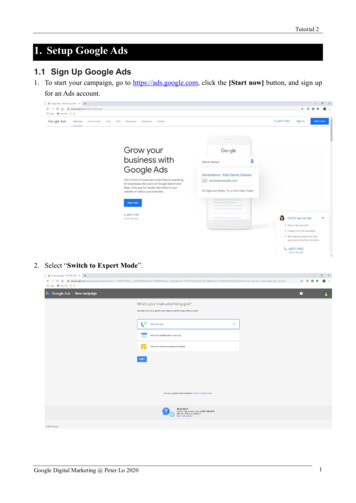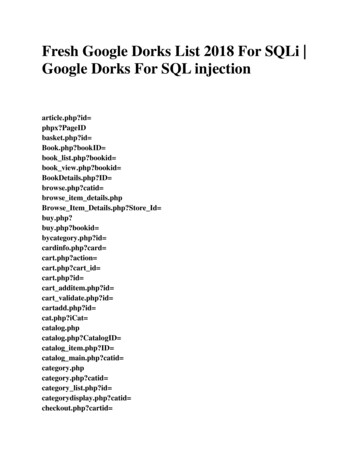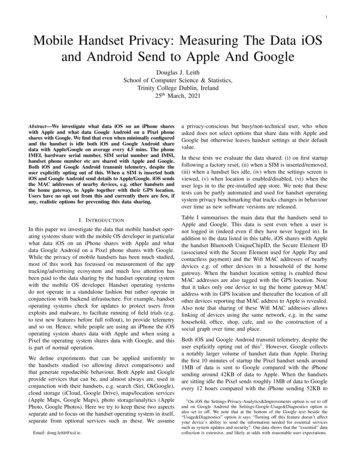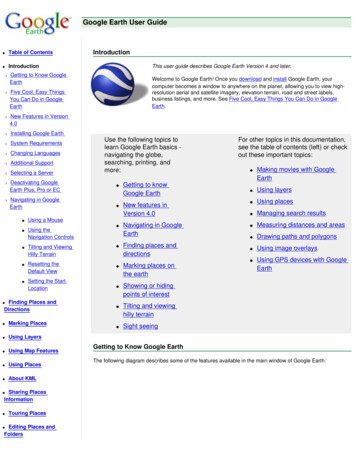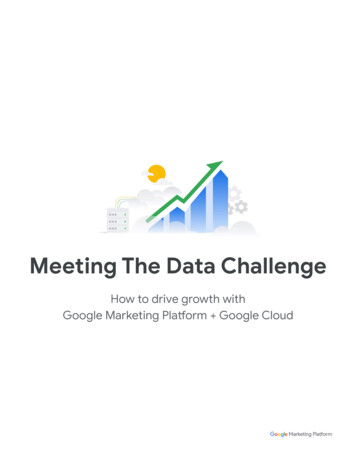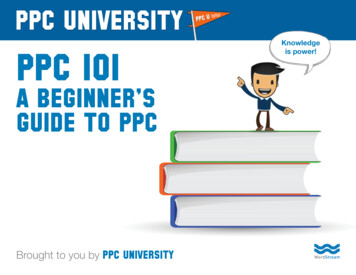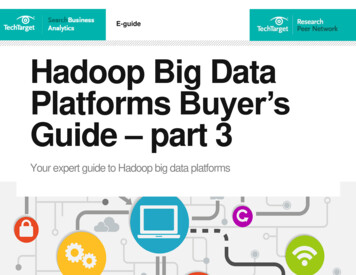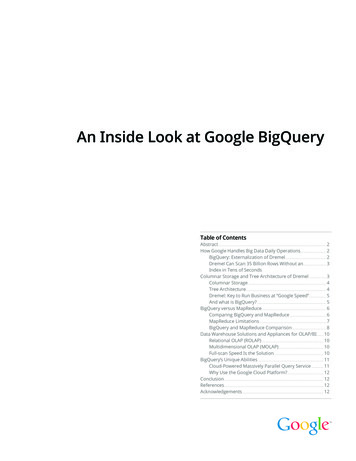
Transcription
An Inside Look at Google BigQueryTable of ContentsAbstract. . . . . . . . . . . . . . . . . . . . . . . . . . . . . . . . . . . . . . . . . . . . . . . . . . . . . . . . . . . . . . . . . . . . . . . . . . . . . . . . . . . . . . . . . . 2How Google Handles Big Data Daily Operations. . . . . . . . . . . . . . . . . . . . . . 2BigQuery: Externalization of Dremel. . . . . . . . . . . . . . . . . . . . . . . . . . . . . . . . . . 2Dremel Can Scan 35 Billion Rows Without an. . . . . . . . . . . . . . . . . . . 3Index in Tens of SecondsColumnar Storage and Tree Architecture of Dremel. . . . . . . . . . . . . . . 3Columnar Storage. . . . . . . . . . . . . . . . . . . . . . . . . . . . . . . . . . . . . . . . . . . . . . . . . . . . . . . . . . . . . . . . . 4Tree Architecture. . . . . . . . . . . . . . . . . . . . . . . . . . . . . . . . . . . . . . . . . . . . . . . . . . . . . . . . . . . . . . . . . . . 4Dremel: Key to Run Business at “Google Speed”. . . . . . . . . . . . . . 5And what is BigQuery?. . . . . . . . . . . . . . . . . . . . . . . . . . . . . . . . . . . . . . . . . . . . . . . . . . . . . . . . . . 5BigQuery versus MapReduce. . . . . . . . . . . . . . . . . . . . . . . . . . . . . . . . . . . . . . . . . . . . . . . . . . . . . . 6Comparing BigQuery and MapReduce. . . . . . . . . . . . . . . . . . . . . . . . . . . . . . . 6MapReduce Limitations. . . . . . . . . . . . . . . . . . . . . . . . . . . . . . . . . . . . . . . . . . . . . . . . . . . . . . . . 7BigQuery and MapReduce Comparison. . . . . . . . . . . . . . . . . . . . . . . . . . . . . 8Data Warehouse Solutions and Appliances for OLAP/BI. . . . . . 10Relational OLAP (ROLAP). . . . . . . . . . . . . . . . . . . . . . . . . . . . . . . . . . . . . . . . . . . . . . . . . . . . 10Multidimensional OLAP (MOLAP). . . . . . . . . . . . . . . . . . . . . . . . . . . . . . . . . . . . . . 10Full-scan Speed Is the Solution. . . . . . . . . . . . . . . . . . . . . . . . . . . . . . . . . . . . . . . . . . 10BigQuery’s Unique Abilities. . . . . . . . . . . . . . . . . . . . . . . . . . . . . . . . . . . . . . . . . . . . . . . . . . . . . . . 11Cloud-Powered Massively Parallel Query Service. . . . . . . . . . . 11Why Use the Google Cloud Platform?. . . . . . . . . . . . . . . . . . . . . . . . . . . . . . . 12Conclusion. . . . . . . . . . . . . . . . . . . . . . . . . . . . . . . . . . . . . . . . . . . . . . . . . . . . . . . . . . . . . . . . . . . . . . . . . . . . . . . . . . . 12References. . . . . . . . . . . . . . . . . . . . . . . . . . . . . . . . . . . . . . . . . . . . . . . . . . . . . . . . . . . . . . . . . . . . . . . . . . . . . . . . . . . 12Acknowledgements. . . . . . . . . . . . . . . . . . . . . . . . . . . . . . . . . . . . . . . . . . . . . . . . . . . . . . . . . . . . . . . . . . . . 12
White Paper BigQueryAn Inside Look at Google BigQueryby Kazunori Sato, Solutions Architect, Cloud Solutions teamAbstractThis white paper introduces Google BigQuery, a fully-managed and cloudbased interactive query service for massive datasets. BigQuery is the externalimplementation of one of the company’s core technologies whose code nameis Dremel. This paper discusses the uniqueness of the technology as a cloudenabled massively parallel query engine, the differences between BigQueryand Dremel, and how BigQuery compares with other technologies such asMapReduce/Hadoop and existing data warehouse solutions.How Google Handles Big Data Daily OperationsGoogle handles Big Data every second of every day to provide services likeSearch, YouTube, Gmail and Google Docs.Can you imagine how Google handles this kind of Big Data during dailyoperations? Just to give you an idea, consider the following scenarios: What if a director suddenly asks, “Hey, can you give me yesterday’s numberof impressions for AdWords display ads – but only in the Tokyo region?”. Or, “Can you quickly draw a graph of AdWords traffic trends for this particularregion and for this specific time interval in a day?”What kind of technology would you use to scan Big Data at blazing speeds soyou could answer the director’s questions within a few minutes? If you workedat Google, the answer would be Dremel1.Dremel is a query service that allows you to run SQL-like queries against very,very large data sets and get accurate results in mere seconds. You just need abasic knowledge of SQL to query extremely large datasets in an ad hoc manner.At Google, engineers and non-engineers alike, including analysts, tech supportstaff and technical account managers, use this technology many times a day.BigQuery: Externalization of DremelBefore diving into Dremel, we should briefly clarify the difference betweenDremel and Google BigQuery. BigQuery is the public implementation of Dremelthat was recently launched to general availability. BigQuery provides the coreset of features available in Dremel to third party developers. It does so via aREST API, a command line interface, a Web UI, access control and more, whilemaintaining the unprecedented query performance of Dremel.In this paper, we will be discussing Dremel’s underlying technology, and thencompare its externalization, BigQuery, with other existing technologies likeMapReduce, Hadoop and Data Warehouse solutions.2
Dremel Can Scan 35 Billion Rows Without an Index in Tens of SecondsDremel, the cloud-powered massively parallel query service, shares Google’sinfrastructure, so it can parallelize each query and run it on tens of thousandsof servers simultaneously. You can see the economies of scale inherentin Dremel.Google’s Cloud Platform makes it possible to realize super fast queryperformance at very attractive cost-to-value ratio. In addition, there’s no capitalexpenditure required on the user’s part for the supporting infrastructure.As an example, let’s consider the following SQL query, which requests theWikipedia content titles that includes numeric characters in it:select count(*) from publicdata:samples.wikipedia where REGEXP MATCH(title, ‘[0-9]*’) AND wp namespace 0;Notice the following: This “wikipedia” table holds all the change history records on Wikipedia’sarticle content and consists of 314 millions of rows – that’s 35.7GB. The expression REGEXP MATCH(title, ‘[0-9] ’) means it executes a regularexpression matching on title of each change history record to extract rowsthat includes numeric characters in its title (e.g. “List of top 500 Major LeagueBaseball home run hitters” or “United States presidential election, 2008”). Most importantly, note that there was no index or any pre-aggregated valuesfor this table prepared in advance.When you issue the query above on BigQuery, you get the following results withan interactive response time of 10 seconds in most cases.223,163,387Here, you can see that there are about 223 million rows of Wikipedia changehistories that have numeric characters in the title. This result was aggregatedby actually applying regular expression matching on all the rows in the table asa full scan.Dremel can even execute a complex regular expression text matching on ahuge logging table that consists of about 35 billion rows and 20 TB, in merelytens of seconds. This is the power of Dremel; it has super high scalability andmost of the time it returns results within seconds or tens of seconds no matterhow big the queried dataset is.Columnar Storage and Tree Architecture of DremelWhy Dremel can be so drastically fast as the examples show? Theanswer can be found in two core technologies which gives Dremel thisunprecedented performance:1. Columnar Storage. Data is stored in a columnar storage fashion whichmakes possible to achieve very high compression ratio and scan throughput.2. Tree Architecture is used for dispatching queries and aggregating resultsacross thousands of machines in a few seconds.3
Columnar StorageDremel stores data in its columnar storage, which means it separates a recordinto column values and stores each value on different storage volume, whereastraditional databases normally store the whole record on one volume.Columnar storage of DremelThis technique is called Columnar storage and has been used in traditional datawarehouse solutions. Columnar storage has the following advantages: Traffic minimization. Only required column values on each query are scannedand transferred on query execution. For example, a query “SELECT top(title)FROM foo” would access the title column values only. In case of the Wikipediatable example, the query would scan only 9.13GB out of 35.7GB. Higher compression ratio. One study3 reports that columnar storage canachieve a compression ratio of 1:10, whereas ordinary row-based storage cancompress at roughly 1:3. Because each column would have similar values,especially if the cardinality of the column (variation of possible column values)is low, it’s easier to gain higher compression ratios than row-based storage.Columnar storage has the disadvantage of not working efficiently whenupdating existing records. In the case of Dremel, it simply doesn’t supportany update operations. Thus the technique has been used mainly in read-onlyOLAP/BI type of usage.Although the technology has been popular as a data warehouse databasedesign, Dremel is one of the first implementations of a columnar storage-basedanalytics system that harnesses the computing power of many thousands ofservers and is delivered as a cloud service.Tree ArchitectureOne of the challenges Google had in designing Dremel was how to dispatchqueries and collect results across tens of thousands of machines in a matterof seconds. The challenge was resolved by using the Tree architecture. Thearchitecture forms a massively parallel distributed tree for pushing downa query to the tree and then aggregating the results from the leaves at ablazingly fast speed.4
Tree architecture of DremelBy leveraging this architecture, Google was able to implement the distributeddesign for Dremel and realize the vision of the massively parallel columnarbased database on the cloud platform.These previous technologies are the reason of the breakthrough of Dremel’sunparalleled performance and cost advantage.For technical details on columnar storage and tree architecture of Dremel,refer to the Dremel paper1 .Dremel: Key to Run Business at “Google Speed”Google has been using Dremel in production since 2006 and has beencontinuously evolving it for the last 6 years. Examples of applications include1: Analysis of crawled web documents Tracking install data for applications in the Android Market Crash reporting for Google products OCR results from Google Books Spam analysis Debugging of map tiles on Google Maps Tablet migrations in managed Bigtable instances Results of tests run on Google’s distributed build system Disk I/O statistics for hundreds of thousands of disks Resource monitoring for jobs run in Google’s data centers Symbols and dependencies in Google’s codebaseAs you can see from the list, Dremel has been an important core technologyfor Google, enabling virtually every part of the company to operate at “Googlespeed” with Big Data.And what is BigQuery?Google recently released BigQuery as a publicly available service for any businessor developer to use. This release made it possible for those outside of Google toutilize the power of Dremel for their Big Data processing requirements.5
Figure 1 Querying Sample Wikipedia Table on BigQuery(You can try out BigQuery by simply sign up for it.)BigQuery provides the core set of features available in Dremel to third partydevelopers. It does so via a REST API, command line interface, Web UI,access control, data schema management and the integration with GoogleCloud Storage.BigQuery and Dremel share the same underlying architecture and performancecharacteristics. Users can fully utilize the power of Dremel by using BigQueryto take advantage of Google’s massive computational infrastructure. Thisincorporates valuable benefits like multiple replication across regions andhigh data center scalability. Most importantly, this infrastructure requires nomanagement by the developer.BigQuery versus MapReduceIn the following sections, we will discuss how BigQuery compares to existingBig Data technologies like MapReduce and data warehouse solutions.Google has been using MapReduce for Big Data processing for quite some time,and unveiled this in a research paper2 in December of 2004. Some readers mayhave heard about this product, and its open source implementation Hadoop,and may wonder about the difference between the two. This is the difference: Dremel is designed as an interactive data analysis tool for large datasets MapReduce is designed as a programming framework to batch processlarge datasetsMoreover, Dremel is designed to finish most queries within seconds or tensof seconds and can even be used by non-programmers, whereas MapReducetakes much longer (at least minutes, and sometimes even hours or days) tofinish processing a dataset query.Comparing BigQuery and MapReduceMapReduce is a distributed computing technology that allows you to implementcustom “mapper” and “reducer” functions programmatically and run batchprocesses with them on hundreds or thousands of servers concurrently. Thefollowing figure shows the data flow involved. Mappers extract words fromtext, and reducers aggregates the counts of each word.6
Figure 2 MapReduce Data FlowBy using MapReduce, enterprises can cost-effectively apply parallel dataprocessing on their Big Data in a highly scalable manner, without bearing theburden of designing a large distributed computing cluster from scratch, orpurchasing expensive high-end relational database solutions or appliances.In the last several years, Hadoop, the open-source implementation ofMapReduce, has been a popular technology for processing Big Data forvarious applications such as log analysis, user activity analysis for social apps,recommendation engines, unstructured data processing, data mining, andtext mining, among others.MapReduce LimitationsAs a former AdWords API traffic analyst, I sometimes used Google’s internalMapReduce frontend called Tenzing4 (which is similar to Hive because itworks as a SQL frontend for Hadoop) to execute multiple join operationsacross extremely large tables of ads data. The objective was to merge andfilter them, under certain conditions, in order to to extract a list of ads for agroup of accounts. MapReduce works well in scenarios like this, deliveringresults in a reasonable amount of time (such as, tens of minutes). If I had usedtraditional relational database technology, this same query would have takenan unreasonable amount time at a high cost, or simply it would have beenimpossible to perform the task at all.However, MapReduce was only a partial solution, capable of handling abouta third of my problem. I couldn’t use it when I needed nearly instantaneousresults because it was too slow. Even the simplest job would take severalminutes to finish, and longer jobs would take a day or more. In addition, ifthe result was incorrect due to an error in the MapReduce code I wrote, I’dhave to correct the error and restart the job all over again.MapReduce is designed as a batch processing framework, so it’s not suitable forad hoc and trial-and-error data analysis. The turnaround time is too slow, anddoesn’t allow programmers to perform iterative or one-shot analysis tasks onBig Data.Simply put, if I had only used MapReduce, I couldn’t have gone home until thejob was finished late at night. By using Dremel instead of MapReduce on abouttwo-thirds of all my analytic tasks, I was able to finish the job by lunch time. Andif you’ve ever eaten lunch at Google, you know that’s a big deal.7
The following figure shows a comparison of execution times between MapReduceand Dremel. As you can see, there is a difference in orders of magnitude.Figure 3 MapReduce and Dremel Execution Time ComparisonThe comparison was done on 85 billion records and 3000 nodes. “MR-records” refers to MapReducejobs accessing row-based storage whereas “MR-columns” refers to MR jobs with column-basedstorage. For more information, refer to section 7. EXPERIMENTS of the Dremel: Interactive Analysisof Web-Scale Datasets paper1.MapReduce and Dremel are both massively parallel computing infrastructures,but Dremel is specifically designed to run queries on Big Data in as little as afew seconds.BigQuery and MapReduce ComparisonBigQuery and MapReduce are fundamentally different technologies and eachhas different use cases. The following table compares the two technologies andshows where they apply.Key DifferencesBigQueryMapReduceWhat is it?Query service for largedatasetsProgramming model forprocessing large datasetsCommon use casesAd hoc and trial-and- errorinteractive query of largedataset for quick analysisand troubleshootingBatch processing oflarge dataset for timeconsuming data conversionor aggregationOLAP/BI use caseYesNoData Mining use casePartially (e.g. preflight dataanalysis for data mining)YesVery fast responseYesNo (takes minutes - days)Easy to use for nonprogrammers (analysts,tech support, etc)YesNo (requires Hive/Tenzing)Programming complex dataprocessing logicNoYesProcessing unstructured dataPartially (regular expressionmatching on text)YesSample use cases8
Data handlingHandling large results /Join large tableNo (as of Sept 2012)YesUpdating existing dataNoYesFigure 4 MapReduce and BigQuery ComparisonBigQuery is designed to handle structured data using SQL. For example, youmust to define a table in BigQuery with column definition, and then import datafrom a CSV (comma separated values) file into Google Cloud Storage and theninto BigQuery. You also need to express your query logic in a SQL statement.Naturally, BigQuery is suitable for OLAP (Online Analytical Processing) or BI(Business Intelligence) usage, where most of the queries are simple and donethrough a quick aggregation and filtering by a set of columns (dimensions).MapReduce is a better choice when you want to process unstructured dataprogrammatically. The mappers and reducers can take any kind of data andapply complex logic to it. MapReduce can be used for applications such as datamining where you need to apply complex statistical computation or data miningalgorithms to a chunk of text or binary data. And also, you may want to useMapReduce if you need to output gigabytes of data, as in the case of mergingtwo big tables.For example, users may want to apply these criteria to decide what technologyto use:Use BigQuery Finding particular records with specified conditions. For example, to findrequest logs with specified account ID. Quick aggregation of statistics with dynamically-changing conditions. Forexample, getting a summary of request traffic volume from the previous nightfor a web application and draw a graph from it. Trial-and-error data analysis. For example, identifying the cause of trouble andaggregating values by various conditions, including by hour, day and etc.Use MapReduce Executing a complex data mining on Big Data which requires multipleiterations and paths of data processing with programmed algorithms. Executing large join operations across huge datasets. Exporting large amount of data after processing.Of course, you can make the best use of both technologies by combining themto build a total solution. For example, Use MapReduce for large join operations and data conversions, then useBigQuery for quick aggregation and ad-hoc data analysis on the result dataset. Use BigQuery for a preflight check by quick data analysis, then write andexecute MapReduce code to execute a production data processing ordata mining.9
Data Warehouse Solutions and Appliances for OLAP/BIMany enterprises have been using data warehouse solutions or appliances fortheir OLAP/BI use cases for many years. Let’s examine the advantages of usingBigQuery for these traditional purposes:In OLAP/BI, you roughly have the following three alternatives for increasingthe performance of Big Data handling. Relational OLAP (ROLAP) Multidimensional OLAP (MOLAP) Full scanRelational OLAP (ROLAP)ROLAP is an OLAP solution based on relational databases (RDB). In orderto make RDB faster, you always need to build indices before running OLAPqueries. Without an index, the response will be very slow when running a queryon Big Data. For this reason, you need to build indices for every possible querybeforehand. In many cases, you need to build many indices to cover all theexpected queries, and their size could become larger than original data. If thedata is really large, sometimes the entire set of data and indices would requireever larger and more complex and expensive hardware to house it.Multidimensional OLAP (MOLAP)MOLAP is an OLAP solution that is designed to build data cubes or data martsbased on dimensions predefined during the design phase. For example, ifyou are importing HTTP access logs into a MOLAP solution, you would choosedimensions such as “time of day”, “requested URI” and “user agent” so thatMOLAP can build a data cube featuring those dimensions and aggregatedvalues. After that, analysts and users can quickly get results for queries suchas “What was the total request count for a specified user agent, grouped byeach time of the day?”.A weakness of MOLAP is that BI engineers must spend extensive time andmoney to design and build those data cubes or data marts before analystscan start using them. Sometimes these designs can be “brittle”, with even theslightest schematic changes causing a failure that requires a new investment inthe whole process.Full-scan Speed Is the SolutionAs you can see, neither ROLAP or MOLAP is suitable for ad hoc queries or trialand-error data analysis, as you need to define all the possible queries at designor import time. In the real world, the ad hoc queries are a major part of OLAPrequirement as we see in the case of a Googler’s daily life: You can never imaginewhat kind of queries you would need in every possible situation. For these usecases, you need to increase the speed of full scan (or table scan), accessing allthe records on disk drives without indexing or pre-aggregated values.As we mentioned in an earlier section, disk I/O throughput is the key to fullscan performance. Traditional data warehouse solutions and appliances havetried to achieve better disk I/O throughput with the following technologies: In-memory database or flash storage. The most popular solution is to fillthe database appliance with memory modules and flash storage (SSDs)to process Big Data. This is the best solution if you don’t have any costrestrictions. Appliance products comprised of SSDs can cost hundredsof thousands of dollars when used to store Big Data.10
Columnar storage. This technology stores each record’s column value indifferent storage volumes. This allows for higher compression ratio anddisk I/O efficiency than ordinary row-based storage. Columnar storagehas become a standard technology for data warehouse solutions sincethe 1990s; BigQuery (Dremel) fully utilizes it with better optimization. Parallel disk I/O. The last and most important factor in improving thethroughput is the parallelism of disk I/O. The full-scan performance willincrease linearly, in relation to the number of disk drives working in parallel.Some data warehouse appliances provide special storage units that allow youto run a query in parallel on tens or hundreds of disk drives. But again, sincethese appliances and storage solutions are all on-premise and proprietaryhardware products, they tend to be quite expensive.BigQuery solves the parallel disk I/O problem by utilizing the cloud platform’seconomy of scale. You would need to run 10,000 disk drives and 5,000processors simultaneously to execute the full scan of 1TB of data withinone second. Because Google already owns a huge number of disk drives in itsown data centers, why not use them to realize this kind of massive parallelism?BigQuery’s Unique AbilitiesBased on Dremel’s novel approach, BigQuery provides extremely high costeffectiveness and full-scan performance for ad hoc queries thanks to the uniquecombination of a massively parallel query engine.Cloud-Powered Massively Parallel Query ServiceUntil now, this level of query performance – full scanning of 35B rows in tensof seconds without an index – has been achieved only by very expensive datawarehouse appliances or by carefully integrated cluster of database serversequipped with full memory and flash storage.Prior to the release of BigQuery, companies were spending hundreds ofthousands of dollars or more to effectively query this amount of data6.In comparison, BigQuery’s cost is drastically lower. To appreciate the differencein price, consider the Wikipedia query example we explored at the beginning ofthis paper. If you execute the query on BigQuery, it would cost you just 0.32for each query plus 4.30 per month for Google Cloud Storage. As you can see,there’s a huge cost savings with BigQuery versus traditional data warehousesolutions.Note that BigQuery scans only the required columns for a query, not all the columns.Each query costs 0.035 per GB as of July 31, 2012. This example query requires 9.13 GBto scan, so it costs 0.035 x 9.13 GB 0.32 per query. Refer to the BigQuery pricing pricing) for detailed price information.How to Import Big DataImporting data into BigQuery is the first challenge to overcome when workingwith Big Data.This is done following this two steps process:1. Upload your data to Google Cloud Storage. Most of the time, the bottleneckwill be your network bandwidth available to perform this step.2. Import the files to BigQuery. This step can be executed by a command-linetool, Web UI or API, which can typically import roughly 100 GB within a halfhour. Refer to the document opers guide#importingatable) for details.11
AcknowledgementsI would like to thank the people who helpedin writing and reviewing this white paper,including Ju-kay Kwek, Michael Manoochehri,Ryan Boyd, Hyun Moon, Chris Elliot, NingTang, Helen Chou, Raj Sarkar, Michael Miele,Laura Bergheim, Elizabeth Markman, JimCaputo, Ben Bayer, Dora Hsu and Urs Hoelzle.I appreciate your contribution so much.Once these solutions are available, it is easier to extract Big Data from a legacydatabase, apply transformations or clean-ups and import them to BigQuery.Why Use the Google Cloud Platform?The initial investment required to import data into the cloud is offset by thetremendous advantages offered by BigQuery. For example, as a fully-managedservice, BigQuery requires no capacity planning, provisioning, 24x7 monitoringor operations, nor does it require manual security patch updates. You simplyupload datasets to Google Cloud Storage of your account, import them intoBigQuery, and let Google’s experts manage the rest. This significantly reducesyour total cost of ownership (TCO) for a data handling solution.Growing datasets have become a major burden for many IT department usingdata warehouse and BI tools. Engineers have to worry about so many issuesbeyond data analysis and problem-solving. By using BigQuery, IT teams canget back to focusing on essential activities such as building queries to analyzebusiness-critical customer and performance data.Also, BigQuery’s REST API enables you to easily build App Engine-baseddashboards and mobile front-ends. You can then put meaningful data intothe hands of associates wherever and whenever they need it.ConclusionBigQuery is a query service that allows you to run SQL-like queries againstmultiple terabytes of data in a matter of seconds. The technology is one of theGoogle’s core technologies, like MapReduce and Bigtable, and has been usedby Google internally for various analytic tasks since 2006. Google has launchedGoogle BigQuery, an externalized version of Dremel. This release made itpossible for developers and enterprises to utilize the power of Dremel fortheir Big Data processing requirements and accelerate their business at thesame swift pace.While MapReduce is suitable for long-running batch processes such as datamining, BigQuery is the best choice for ad hoc OLAP/BI queries that requireresults as fast as possible. BigQuery is the cloud-powered massively parallelquery database that provides extremely high full-scan query performanceand cost effectiveness compared to traditional data warehouse solutionsand appliances.References1. Dremel: Interactive Analysis of Web-Scale Datasets http://research.google.com/pubs/pub36632.html2. MapReduce: Simplified Data Processing on Large Clusters . Column-Oriented Database Systems, Stavros Harizopoulos, Daniel Abadi, Peter Boncz, VLDB 2009 Column Store Tutorial VLDB09.pdf4. Tenzing A SQL Implementation On The MapReduce Framework http://research.google.com/pubs/pub37200.html5. Protocol Buffers – Google’s data interchange format http://code.google.com/p/protobuf/6. Price comparison for Big Data Appliance, Jean-Pierre Dijcks, Oracle g/entry/price comparison for big data 2012 Google Inc. All rights reserved. Google, YouTube, the Google logo, and the YouTube logo are trademarks of Google Inc.All other company and product names may be trademarks of the respective companies with which they are associated.WP2031-1210
Google handles Big Data every second of every day to provide services like Search, YouTube, Gmail and Google Docs. . What if a director suddenly asks, “Hey, can you give me yesterday’s number of impressions for AdWords display ads – but only in the Tokyo region?”. Or, “Can you quickly dr

